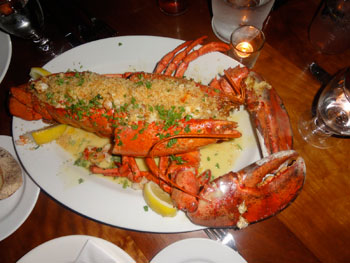 I am not certain, but I fear we foodies of Martha’s Vineyard don’t measure up to the truly high standards of obnoxious and perfectionist self-importance that other summer colony foodies get to display. (The Hamptons and the state of Maine come to mind.) I am embarrassed that there are only so many uppity remarks available to us if the lobster roll wasn’t toasted in butter, and what can you say other than “more please” when devouring freshly shucked Katama oysters or Atria’s wok fried whole lobster? Lazy and content, (and now that summer is officially over) we find ourselves with the end of summer blues, and boy, are they running.
I am not certain, but I fear we foodies of Martha’s Vineyard don’t measure up to the truly high standards of obnoxious and perfectionist self-importance that other summer colony foodies get to display. (The Hamptons and the state of Maine come to mind.) I am embarrassed that there are only so many uppity remarks available to us if the lobster roll wasn’t toasted in butter, and what can you say other than “more please” when devouring freshly shucked Katama oysters or Atria’s wok fried whole lobster? Lazy and content, (and now that summer is officially over) we find ourselves with the end of summer blues, and boy, are they running.
Bluefish abound in our fish markets especially smoked bluefish. Now this is an area where we Vineyard foodies can almost strut our stuff: Looking at a piece of smoked bluefish produces the obvious foodie smirk. “Where did you get your fish?” If your answer isn’t John’s or Larsen’s then it bloody well better be something akin to, “Oh I have a friend who lives in the attic over Karen’s garage. He catches and smokes a few fish every week for friends…but they are not for sale.” (I can relate to bluefish as their travel habits mimic ours: Found in Florida waters during winter, they make their way to Massachusetts by June, avoiding the Memorial Day crush of late May). Smoked blue fish served with honey mustard is the ubiquitous cocktail party spread at any Vineyard party, and, I really don’t care where it comes from.

 I got sick last week. Sick like “Oh my god, I’m never going to walk again.” Sick like, “Should I go to hospital now?” Sick like stomach virus. out sick Liquid Alison. It was the worst, though luckily it moved through me quickly, so to speak. After hours of sleeping cocoon-style on the couch, I realized I would have to put something into my body. I stood in my kitchen, staring at my shelves, wrapped in a blanket, moaning slightly as my dogs rolled their eyes. It had to be simple to make and easy to eat. My eyes scanned the shelves: quinoa, polenta, whole wheat penne, vermicelli, and then focused on a box of small shells, half of which I had cooked for a child’s mac and cheese a long time ago. That I could do. Pasta is easy.
I got sick last week. Sick like “Oh my god, I’m never going to walk again.” Sick like, “Should I go to hospital now?” Sick like stomach virus. out sick Liquid Alison. It was the worst, though luckily it moved through me quickly, so to speak. After hours of sleeping cocoon-style on the couch, I realized I would have to put something into my body. I stood in my kitchen, staring at my shelves, wrapped in a blanket, moaning slightly as my dogs rolled their eyes. It had to be simple to make and easy to eat. My eyes scanned the shelves: quinoa, polenta, whole wheat penne, vermicelli, and then focused on a box of small shells, half of which I had cooked for a child’s mac and cheese a long time ago. That I could do. Pasta is easy. When I was 4 years old I was on Kids Say The Darndest Things with Art Linkletter. My folks told me the teacher in our Nursery School recommended me. When I think about the fact that I once called her ‘fatso’ just to try out the word, nothing personal, and she got so mad she locked me in a broom closet, I’m ever convinced of the altruism of teachers.
When I was 4 years old I was on Kids Say The Darndest Things with Art Linkletter. My folks told me the teacher in our Nursery School recommended me. When I think about the fact that I once called her ‘fatso’ just to try out the word, nothing personal, and she got so mad she locked me in a broom closet, I’m ever convinced of the altruism of teachers. If a group of 10 people playing the word association game were given the word “summer”, chances are at least half would say picnic. Probably more. For me, the best summer picnic, the only summer picnic, is a beach picnic. My family wasn’t park picnickers or picnic in the woods people. We were Long Island beach lovers. And that’s where we did our picnicking.
If a group of 10 people playing the word association game were given the word “summer”, chances are at least half would say picnic. Probably more. For me, the best summer picnic, the only summer picnic, is a beach picnic. My family wasn’t park picnickers or picnic in the woods people. We were Long Island beach lovers. And that’s where we did our picnicking. I wish I could tell you exactly how many yards it was for me to get to Roxbury Park to give you the visual. A hop. Not even a skip and a jump. I walked two houses up, crossed Olympic and I was there.
I wish I could tell you exactly how many yards it was for me to get to Roxbury Park to give you the visual. A hop. Not even a skip and a jump. I walked two houses up, crossed Olympic and I was there.